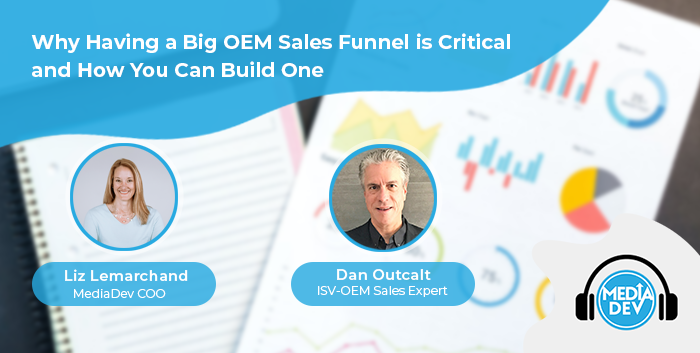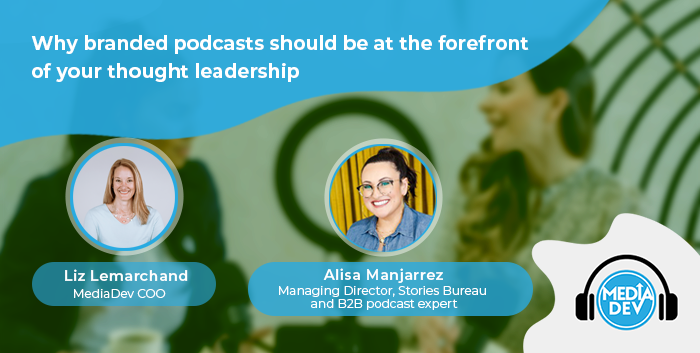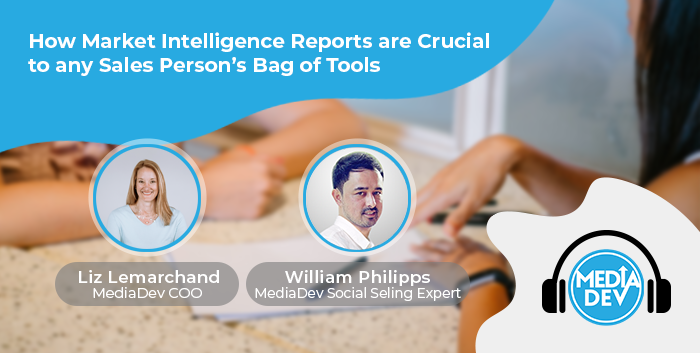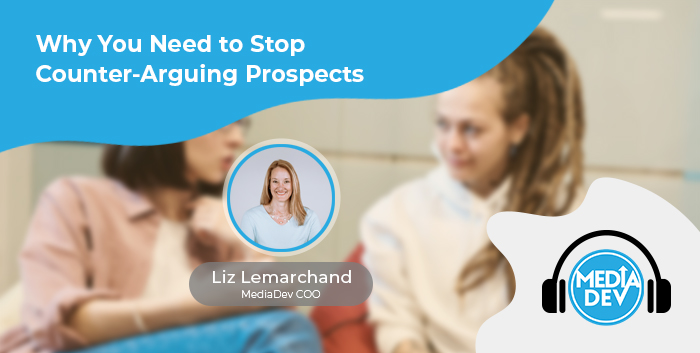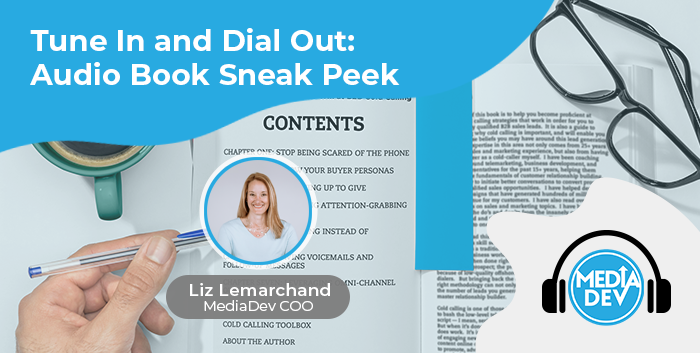Liz talks with Sander Oostewechel (MediaDev Marketing Manager) about the value of launching ad campaigns to promote your content or events on the world’s largest professional social network.
Listen to the episode on Apple Podcast, Google Podcasts, Spotify, Breaker, Pocket casts, RadioPublic, or Anchor, or read the transcript below.
SHOW NOTES
Why it’s a good idea to advertise on LinkedIn and what are some of the benefits of putting marketing budget into that activity? [00:00:55]
What type of content should be used to generate leads through LinkedIn advertising? [00:05:08]
What are some of the best ads from a performance standpoint and what results can someone expect to get when they do a LinkedIn ad? [00:08:41]
What are the differences between sponsored Inmail messages and banner ads? [00:12:34]
What are the steps in running a new campaign [00:14:29]
What are some things to watch out for and how to make sure an ad campaign is a success? [00:21:25]
If you’ve enjoyed this episode, please subscribe via Apple Podcast | Google Podcasts | Spotify | Anchor to automatically get the next ones!
Thanks for Listening Today!
Share it with someone you believe will also benefit from listening to it. Use the share buttons below! They’ll thank you for it.
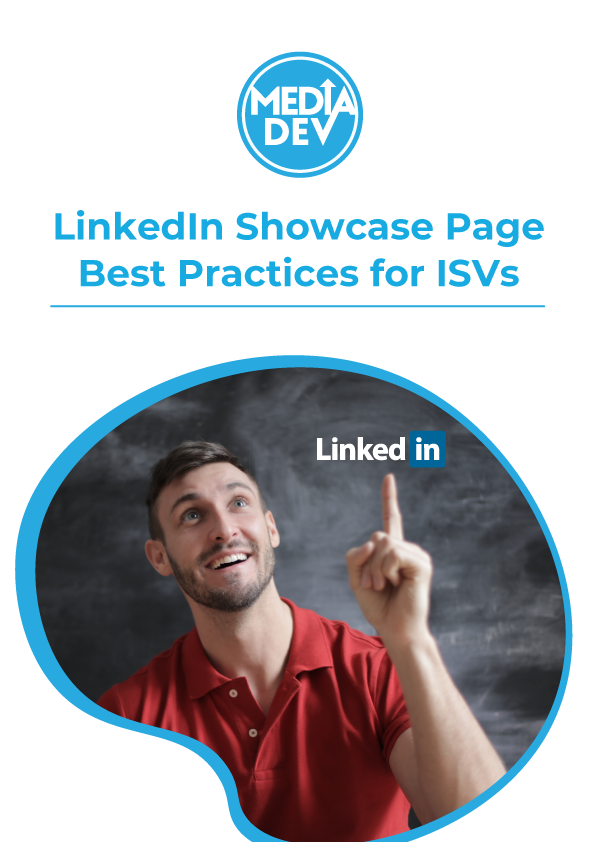
Transcript
Liz Lemarchand: How is it that innovative software solutions have the ability to change the world yet they don’t sell themselves? How is it that I know my target market but I’m not able to generate enough sales opportunities? How do I even get started to create visibility for my brand when I’m not an expert in marketing, that is the question and this podcast will give you the answer. Welcome to simplified software marketing made simple.
Hey everyone, this is Liz from Media Dev and today I am joined by Sander, our head of digital marketing.
Hi, Sander, how are you today?
Sander Oostewechel: Hi, Liz, I’m good, thanks and you.
Liz Lemarchand: I’m good, thanks. And today we’re going to be talking about the best practices for LinkedIn advertising, so I’m just going to dive right in with question number one. So, Sander, why is it a good idea to advertise on LinkedIn and what are some of the benefits of putting marketing budget into that activity?
Sander Oostewechel: Well, I think there are like 2 that really make LinkedIn an important target and definitely worth it to explore if you haven’t done so, and the first point is that LinkedIn ads give you immediate exposure to your target audience.
You know organic campaigns often take a lot of time to build up because you have to recruit a network organically, and that usually involves creating a lot of content, making sure content quality is good so that people start to follow you and share your content, and that just takes time.
But with LinkedIn ads you have the opportunity to expose content immediately after launching the campaign to your target audience and while organic campaigns are great over time and you build up an audience that you really own and that you don’t have to pay for overtime. So, that’s a super important tactic as well, but typically with, let’s say, assets that have an expiration date, for example, if we did a report or research on a quarterly basis into an industry or something like that but that’s information that expires or an event, for example, those are great types of content to publish and expose through ads because they have this “expiration date”, and you often don’t have the time to build up an organic audience to promote such an asset if you don’t have an organic, existing organic audience.
So, I think that’s one major aspect of the ads. You get immediate exposure and that, by the way, counts for all kinds of ads, not only on LinkedIn but also on Facebook or on Google. But what does speak for LinkedIn is that with their advertising platform we can really super precisely target the audiences and you can do that based on geographic location. You can do that based on company characteristics such as industries, the company size. You could even dive into specific buyer personas by defining job titles or polls, or the seniority, if you for example were to target, I don’t know the management like directors, VP, CEOs, those are all kinds of criteria that you could set. And yeah, hyper-target your target audience and over the recent years, they’ve even gone further with more specific attributes of personas, like if LinkedIn now obviously is a social media platform, so they collect a huge amount of data and based off of that data they are able to determine what somebody is interested in, what type of content they engage with. So, they even go as far as giving you the possibility to select certain attribute that people are interested in and target your audience in that way.
So, I think those are the two key elements that really make LinkedIn advertising interesting to initiate as a business.
And if I were to add a third thing, maybe that would be that it’s really easy to get started and you’re always in control of what you spend anyway, so there’s not a huge “risk” to get started in the first place and see if it works for you.
Liz Lemarchand: Excellent, you’ve kind of touched on this in your last response about how content expires, but what type of content really should be used to generate leads through LinkedIn advertising.
Sander Oostewechel: I suppose that would depend on the goal of your advertising campaign. I mean, if you advertise, you could have different types of goals. It could be that you’re looking to create exposure for your brand, so some kind of brand recognition, in general, that could be just to make your brand name appear across LinkedIn, but it could also be that you’re actually looking to generate leads through LinkedIn advertising and that’s what you’re really asking your question. So, you could do that in different ways. And I think the most common way is to place an advertisement on LinkedIn. Have users click on your advertisement and then direct these people to a landing page on your website and then on your website, on this landing page you would convince users I don’t know — download an asset or subscribe or sign up for something and that way, convert the user of LinkedIn into a lead that you can further nurture. So, you could do that.
So, one type of content that you could promote is a landing page really where you promote an asset or an event or whatever it is you want to promote.
But secondly, you could also use what LinkedIn calls lead generation forms and those allow you to generate leads directly within LinkedIn. And with those lead generation forms, you can pick an asset. It doesn’t have to be an event per se, it can be something that you should be doing on your website, but you could pick a valuable asset like a white paper or certain research that you did into an industry or a specific case study. It offers value to your target audience and have users of LinkedIn after clicking on your ad, fill out a little form easy and then they click the button download and then LinkedIn submits the information of this lead and you can follow up on that lead.
So yeah, I, I mean, there are a lot of variables and of course, it depends on your target audience what makes sense for them. So always make sure that it resonates and then pick an asset that’s really valuable for that target audience, I wouldn’t really pick something that’s very sales-oriented. Like I wouldn’t, you know, promote my company brochure because that’s not necessarily going to add a lot of value for your target audience. But if it’s something that yeah, if you did an independent research or you have a unique case study that could help your target audience, then that’s something I would promote on LinkedIn.
Liz Lemarchand: Excellent, so what are some of the best ads from a performance standpoint and what results can someone expect to get when they do a LinkedIn ad?
Sander Oostewechel: Yeah, that overlaps a little bit with what I just said, so make sure that the content that you promote resonates with your target audience and offers a lot of value. In addition to that, we also get to the creative side of creating the advertisement and including copywriting or the design of an image or even a video. As a general rule, I would say that you have to really try to keep your text as concise as possible. Try to get the idea or the value across and then after somebody clicks on your advertisement, you have the opportunity to explain the exact content but in the advertisement try to be very concise, so it’s easy to understand and with one or two seconds, so somebody knows what this is and what kind of value the asset or event you’re promoting would provide them.
And another important part of a well-performing ad is that there is a very clear call to action like OK, what is the next step? Because otherwise, people see it. They read it. And then they don’t necessarily know what to do. So a very clear call to action is important ’cause after all LinkedIn is a social media platform.
I don’t know if you’ve experienced it yourself, but while you’re scrolling through your timeline, you’re consuming a huge amount of information in a very short period of time, and if something doesn’t stand out, it’s not clear what to do with it like a split second, then you’re just going to scroll by.
So those I think are some best practices in terms of the creative side. And then, in terms of results that also really depends on your target audience. LinkedIn ads are based on a bidding system, so that means that you’re basically fighting with your competition over advertisement space and you’re competing with other ad publishers over that space and everybody is in control of the budget. I want to spend to be displayed in the available ad space on LinkedIn so that really differs per market.
We see that there’s a big difference between, for example, the United States super competitive market or the UK, also very competitive. And then there are more developing countries across APAC or LATAM, which show usually a lower cost to reach a target audience. So it really depends on the unique situation of a company and their audience to determine what the exact results will be and how much everything is going to cost.
So yeah, there’s not just one clear answer on what somebody can expect upfront and that’s why it’s important to keep it to just get started. See if it works for you. Like I said, you can get started with a few $100 or euros. And then scale up if it works for you and if the competition is not too fierce among your target audience.
Liz Lemarchand: Excellent, so talk to me about the differences between sponsored Inmail messages and banner ads. What’s the difference and how do they work?
Sander Oostewechel: There are different types of advertisements on LinkedIn. They’re indeed sponsored messages. There are banner ads. There are also text ads that are just plain text. There are even videos. And I think the main categories are like text ads that are mainly used for awareness. They will appear across the platform on the right side of the timeline and usually promotes a company or company page. And that’s usually based on awareness. And then there are the so-called like native advertising ads that appear in the timeline. If you’re on LinkedIn, those are the ones that you will, I think most frequently see they appear just as normal posts on LinkedIn, usually with the caption with some copy and an image or multiple images, or a video or something like that. So there’s a difference in placement there. And those all appear in any timeline, and then there’s like this third category which is run messages and that’s an advertisement that is placed in the inbox of a LinkedIn user, and that’s a very interesting advertisement type because it really immediately establishes this one-to-one interaction. We also typically see that there is a very high engagement rate those message ads.
Liz Lemarchand: OK, so if I want to run a new campaign, walk me through the steps. What needs to be done? How long does it take? What’s step 123 and four in that process?
Sander Oostewechel: OK, let’s start from the beginning then. First of all, it’s not really rocket science, but there are a bunch of steps to go through to get to the end result and into launching your campaign.
So first there are couple of let’s say admins tabs. You have to make sure that your company has a company page on LinkedIn and that you’re an admin of that page, because only then you can launch an advertising campaign, a campaign of which the ads appear to be posted by the company that you work for. So that’s really steps one and then you’d have to create a LinkedIn ad account, which is a separate account on LinkedIn and that’s very easy. LinkedIn is very intuitive, so there are few steps to go through and then that’s set up. And once you have your account, you can connect a payment method.
They only offer a credit card option as of now and those are kind of the admin-related steps to get started.
And then you get to the interesting stuff and you can create a campaign. I would always suggest to create separate campaigns for different purposes or assets or target audiences and not to throw everything into one campaign, because that’s how you keep control of all of your campaigns and gain insights into how a certain target audience is performing or how a certain asset is performing, whereas if you throw everything on one pile, you don’t really know what’s working and what’s not working.
That’s one point. Determine the purpose of each campaign and set up different campaigns for each purpose. And so if let’s say I don’t know you wanted to promote an asset, white paper for example, then the next step would be to define your target audience based on all of the criteria that I mentioned earlier.
In our conversation and there are lots of them, you can really pinpoint your target audience, and I would always go as precise as possible or targeted as possible even though that would create a smaller target audience on LinkedIn or slower smaller, which I would still start with a narrow audience. And if you feel like OK, this is working, the audience is engaging, this campaign is running like I wanted to run, then you can experiment with widening the audience and increasing the reach and volume and also your budget finally.
The budget is the next step after you define your audience, you can set up your budget. You’re very much in control. You can set up, for example, a daily maximum, or you can set up a total maximum, and then you will never spend more than the maximum you put you define during your campaign. And once the budget is set then the campaign set up is done and we move to the creative side and then that’s where you create the advertisement that you want to promote. Like I mentioned there are multiple variations of advertisements, but typically it includes writing some copy a few lines, and perhaps an image, or a video or something like that, and obviously you can have an image designed by a designer, but you could also use some kind of free tools like Canva which is really good at creating these images that are specifically made for posting on LinkedIn or Facebook or whatever social media and that’s the creative side.
What I would also recommend is to always create multiple variations of advertisements. So usually I would recommend creating at least three different variations with slightly different copies, slightly different images to allow for optimization, to see what messaging resonates best with your target audience and what leads to the best engagement. And then when you have your creatives done, you’re ready to launch the campaign and the advertisements run.
Liz Lemarchand: Super so then the campaign, really, you can’t determine kind of in advance how long it’s going to take for you to complete from start to finish because then it just depends on how long it takes you to make the copy, how long you want it to run for what your budget is correct?
Sander Oostewechel: Yes, that’s correct. I mean obviously, you’re in control of how much time you spend on creating the advertisements, and it doesn’t really have to take that long. And LinkedIn does give some indication on what you could expect with your defined target audience and budget in terms of REACH in terms of clicks. How much money. How much budget you’re going to spend over, let’s say 30 days. They give some insights into that.
But as I mentioned, the platform is based on a bidding system, I mean there are more factors than that, but the competition can always change and there are only limited ad space available on LinkedIn. So yeah, it’s hard to tell how long a campaign would run for based on your budget exactly, but generally speaking, the larger your audience is, the easier it will be to spend your budget quickly, simply because there’s more advertisement space available.
Liz Lemarchand: So what are some things to watch out for and how can I make sure my ad campaign is a success.
Sander Oostewechel: Well, I mean that’s an obvious one, always keep control of your budget. Don’t spend more than you’re comfortable with, just put a max on especially your first campaigns and see if it works and try to keep optimizing your campaigns. And you do that by looking at the metrics that LinkedIn provides you with. They were very intuitive. Yeah, results panel really with where they display how many times your advertisement has been viewed how many clicks there were? What the engagement with your advertisements is. And that helps you determine if an advertisement is working well or not so well. And if you have multiple ad variations like I just mentioned, you can pick which one works best and continue with that or try to further optimize that one that works best. And then, slowly but surely you will get to a point where you feel like okay, this is how much I’m spending per click, for example, on a leading user to my website and on my website, I know that X amount converts into a customer and a customer is worth a certain amount of money to me.
And once you have that kind of holistic view on how much you put into LinkedIn ads and how much you can get out, how much you get out of it on the bottom line, that’s when you start to invest more and more into the ads. Really, that’s always one piece of advice I always would give is don’t start with LinkedIn ads if we don’t really have a more holistic plan of converting the clicks that you have in your advertisement into actual leads. I think those are the two main points: keep optimizing and make sure that your advertisement campaign is part of a more holistic approach to marketing and converting the people that click on your advertisements and thus the people that you pay for to make sure that they convert into leads in the end and ultimately into customers.
Liz Lemarchand: Excellent, so yes, it’s just part of the puzzle, but not the whole picture.
Sander Oostewechel: Yeah, exactly because in the end, you can’t buy anything from clicks. I mean, if somebody clicks on your advertisement, that’s great. It means that the advertisement has done its job, but then still, you have to make sure that this person converts into a lead, provides contact details, for example, an email address and phone number, and that you then consistently follow up, educate on your offer and turn them into customers.
Liz Lemarchand: Is there anything else that you’d like to add for our listeners today?
Sander Oostewechel: I think your questions were quite good and covered most of the aspects of what LinkedIn is about. So yeah, I think we covered the basics here.
Liz Lemarchand: Excellent and for more information you can check out our website at media dev com or we’ve got tons of interesting resources on our resource library and otherwise feel free to contact us should you have any questions at contact at mediadev.com and we’ll see you back here soon for another episode.
Thanks again, Sander.
Sander Oostewechel Yes, no problem. Thank you, Liz.
Liz Lemarchand: Take care.
You just listened to simplified brought to you by MediaDev. If you have software marketing questions or need help marketing your software solution, reach out to us at contact@mediadev.com and check out other amazing assets for you on our resource library at mediadev.com.


